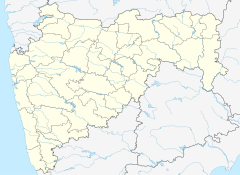Sevagram Junction railway station
This article has multiple issues. Please help improve it or discuss these issues on the talk page. (Learn how and when to remove these messages)
|
Sevagram Junction | |||||
|---|---|---|---|---|---|
| Indian Railways junction station | |||||
 Indian Railways logo | |||||
| General information | |||||
| Location | Wardha, Maharashtra India | ||||
| Coordinates | 20°44′21″N 78°37′07″E / 20.7391°N 78.6185°E | ||||
| Elevation | 279 metres (915 ft) | ||||
| Owned by | Indian Railways | ||||
| Operated by | Central Railway | ||||
| Line(s) | Howrah–Nagpur–Mumbai line New Delhi–Chennai main line | ||||
| Platforms | 5 | ||||
| Tracks | 10 | ||||
| Construction | |||||
| Structure type | At ground | ||||
| Parking | Available | ||||
| Other information | |||||
| Station code | SEGM | ||||
| Division(s) | Nagpur | ||||
| History | |||||
| Opened | 1985 | ||||
| Electrified | 1990–91 | ||||
| |||||
Sevagram railway station is a railway station serving Sevagram town, in Wardha district of Maharashtra state of India. It is under Nagpur railway division of Central Railway zone of Indian Railways. It is an important junction station on the Howrah–Mumbai and Delhi–Chennai trunk line of the Indian Railways. This was known earlier (until the mid 90s) as "Wardha East" (station code WRE)
It is located at 279 m above sea level and has five platforms. As of 2016, at this station, 76 trains stop.[1]
History
The first passenger train in India travelled from Mumbai to Thane on 16 April 1853. By May 1854, Great Indian Peninsula Railway's Bombay–Thane line was extended to Kalyan. Bhusawal railway station was set up in 1860, and in 1867 the GIPR branch line was extended to Nagpur.[2]
Before establishment of Sevagram railway station, north–south-bound trains had to get their engines reversed in opposite direction, which was a very time-consuming process. To avoid this problem, a new station for halting north–south-bound trains was established in 1985, named Sevagram railway station. Since then, trains running on New Delhi–Chennai main line halt at Sevagram railway station, bypassing Wardha railway station.
The railways in the Badnera–Wardha sector were electrified in 1990–1991.[3]
The station has been equipped with new Route Relay Interlocking (RRI) for faster train operation.
Trivia
One amazing trivia is the extremely steep rail curve towards the south of the station. Even the fastest trains slow down considerably after/before Sevagram station in order to mediate this curve.
References
- ^ https://indiarailinfo.com/arrivals/sewagram-junction-segm/19
- ^ "IR History: Early Days – I : Chronology of railways in India, Part 2 (1832–1865)". IRFCA. Retrieved 18 March 2013.
- ^ "History of Electrification". IRFCA. Retrieved 18 March 2013.
External links
| Preceding station | Indian Railways | Following station | ||
|---|---|---|---|---|
| Template:Indian Railways lines | ||||
| Template:Indian Railways lines |


